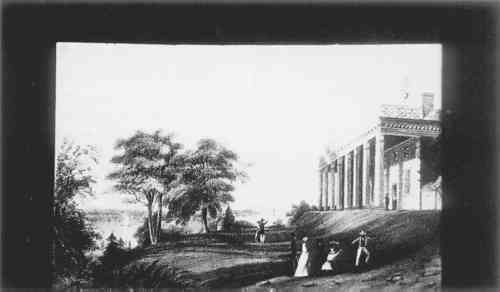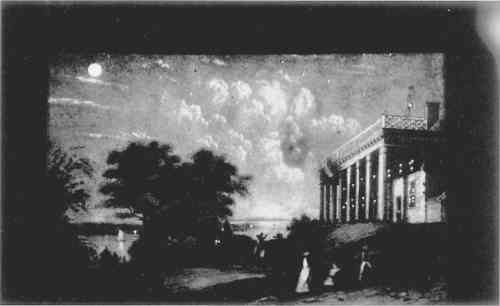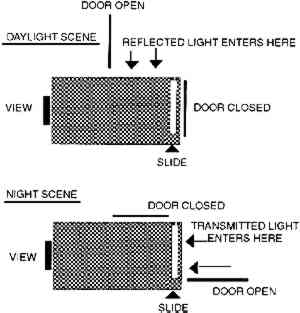A CONSERVATION CASE STUDY OF POLYRAMA PANOPTIQUE PAPER VIEWING SLIDESTED STANLEY
1 INTRODUCTIONThe optical amusement toys and devices known as peepshows may be the best-kept secret of precinematographic history. As a popular form of entertainment throughout the 18th and 19th centuries, they delighted audiences with images of faraway people and places. Using light, perspective, and multiple images that changed when the light source shifted from reflected to transmitted light, they were an early forerunner of a long line of developments that led to the movies we enjoy today. 1.1 THE HISTORY OF OPTICAL AMUSEMENTSLeon Battista Alberti (1404–72), credited as the inventor of the camera obscura, made the first optical amusements known as peepshows (Chilvers and Osborne 1988). As their popularity grew and technology developed, peepshows were produced in a number of forms and styles. The components could be very simple or very grand. In the early 18th century, Sergeant Bell and showmen like him traveled through English towns and fairs with peepshow boxes. For a small sum, children and adults could see exciting scenes of places and events. These peepshows were composed of crude, pinpricked, hand-colored drawings or engravings and colored thread (Balzar 1987). The peep boxes had small glass portholes into which the viewer peered. In the mid-1780s Robert Barker, an English painter, created the Panorama, a continuous realistic landscape painting on a cylindrical canvas, nearly 300 ft. in circumference. The endless canvas was fitted inside of a building, where it revolved around an audience seated in the center (Altick 1973). During the early 1820s Louis Jacques Mand� Daguerre (1789–1851) presented his Diorama, which incorporated many of the ideas of the Panorama such as the cylindrical canvas, but introduced new and interesting features. Daguerre used transparent canvasses, composite imaging, and reflected and transmitted light to create transitions of day and night scenes. His canvas was stationary, and it was the audience area in the center that rotated. Daguerre's Historique et description des procedes du Daguerreotype et du Diorama, gives a detailed description of the methods and materials used to build his invention (Daguerre [1839] 1982). In the 1830s Protean prints or views were popular. These hand-held prints had another image on the back mounted behind the print. When the light source shifted, the visual effects were similar to those of the Diorama (Gasciogne 1986). In a reflected light scene, for example, one might see only a house by a road. Viewing the scene in transmitted light, however, one would see a column of soldiers march down the same road past the house. The Transparent print, popular during the very early 1800s, was similar to the Protean print. It had an image at its verso, produced by the application of watercolor. In addition, varnish was applied to create brilliant highlights when the print was held in transmitted light (Orme 1807). The Polyrama Panoptique, the subject of this study, used the same techniques and optical effects as the Transparent and Protean prints that preceded it. But while Transparent and Protean prints had to be viewed in a dimly lit environment to take advantage of the transmitted light that would be created by a light source such as a candle, the show box of the Polyrama Panoptique contained and controlled the light entering it, making it easier for the viewer to see the effects of both reflected and transmitted light on the print in almost any lighting environment. In this manner transformation of the image was truly magical. The Megalithoscope, invented by Carlo Ponti (1823–93) in 1862, created the same optical effects as the Polyrama Panoptique but used photographic prints instead. 1.2 THE POLYRAMA PANOPTIQUEThe Polyrama Panotique developed in France during the mid-19th century (Freeman 1942; Balzer 1987) consists of a small paper viewing slide placed inside a show box, at the rear. When the viewer peeps into the show box through a glass porthole, the scene seems to come alive, changing from day to night as the viewer changes the light source (figs. 1a, 1b). Reflected light is created when the hinged top lid of the show box is open and its rear door is closed. Transmitted light is created when the rear door is open and the top lid is closed (fig. 2).
The scene that seems to change before the viewer's eyes is created on several planes. What looks like an ordinary hand-colored print attached to a wooden strainer is actually three images on two prints or supports. A primary print is placed over a secondary print, both attached to a strainer along the edges with adhesives in a method comparable to the old European technique of inlaying a print or map. In addition, figures painted on the back side of the print are unseen in reflected light, but in transmitted light, as the print becomes transparent, they appear as if by magic. A secondary print mounted behind the primary print enhances the effects of transmitted light with watercolor washes. Shadows and light become more pronounced, helping to create nighttime effects. Cutouts and perforations in the secondary support, representing an illuminated moon or stars in the night sky, create a dramatic display in the transmitted light. Show boxes were made in different styles, with vertical or horizontal slots for loading slides. One show box, sometimes found in collections, has an accordion or bellows section extending from the front of the box with a round glass porthole, mounted in a bell shaped board. The top lid has a large printed label entitled: POLYRAMA PANOPTIQUE//BREVET D INVENTION S Gte du Gouv. This particular Polyrama Panoptique was made in three sizes: 6 � 5 in., 8.5 � 7 in., and 10 � 9 in. (Balzer 1987). |


